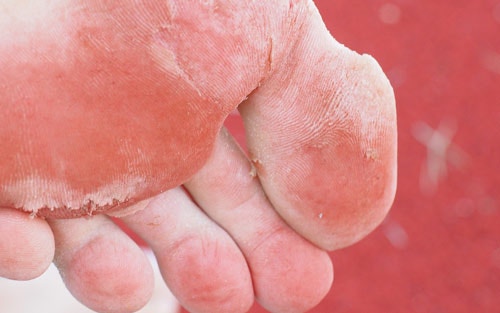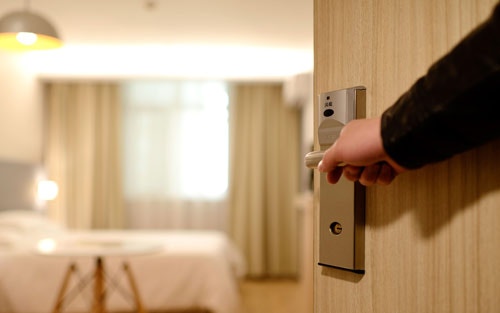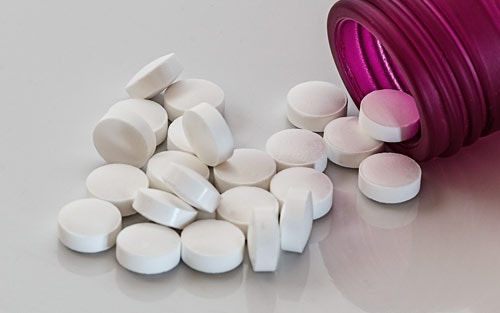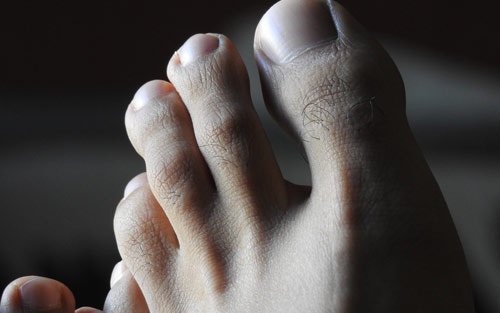Do your smelly or unsightly feet make you uncomfortable taking your shoes off. That pungent foot odor or flaky skin may be athlete’s foot, and the longer you wait to address it, the harder it is to deal with.

This infection is easily treated when caught in its beginning stages but can develop into an extremely uncomfortable and embarrassing condition when allowed to develop freely.
yourfootpalace.com gathered information on the cause, symptoms, treatment, and better yet, prevention of Athlete’s foot.
What Is Athlete’s Foot?
Also known as tinea pedis or ringworm of the foot, athlete’s foot is a fungal infection primarily affecting the feet and is easily transmitted from person to person. The infection usually appears first between the toes and can spread as a rash to other parts of the feet, including infecting and discoloring toenails.
The fungal species genera responsible for athlete’s foot are:
• Trichophyton
• Epidermophyton
• Microsporum
This type of fungal infection is opportunistic and requires a specifically warm and moist environment to grow on the feet.
What Causes Athlete’s Foot?
Athlete’s foot is caused when a person’s feet are continuously exposed to excessive moisture (including sweat) while wearing tight-fitting shoes or shoes that do not breathe. This environment allows any of the infection causing fungi present on the feet to flourish.
How Does Athlete’s Foot Spread?
This fungal infection is easily spread from person to person in locations such as:
• Community Water Parks
• Gym Showers
• Dressing Rooms
• Hotel Rooms
• Bathtub/Shower

The following are means of infection:
• Sharing contaminated socks, or shoes
• Using unsterilized foot care tools
• Touching a contaminated surface (desk, door handle, sheets, and blankets)
• A handshake or other skin to skin contact
• Coming in contact with the condition causing fungi
Basically, once someone is infected, everything their feet come in contact with (including their hands) becomes a source of contamination.
What Are The Symptoms of Athlete’s Foot?
Depending on the fungi and the length of time the infection has had to develop, the following symptoms may vary in intensity:
• Itching, burning, stinging, raw skin, peeling skin, or open wounds between the toes
• Inflammation or swelling
• Rash or blisters that itch
• Dry, flaky skin on the soles or sides of your feet
• Cracking and peeling skin on the soles and heels
• Raw, itchy skin on your feet
• Discolored or deformed toenails
• Thickening toenails that separate from the nail bed
If you are experiencing any, or a combination of the symptoms mentioned above, contact your primary care physician. They may refer you to a podiatrist (foot doctor) or dermatologist (skin doctor), but in most cases, your primary care physician will be able to treat your infection successfully.
How is Athlete’s Foot Diagnosed?
Athlete’s foot is usually diagnosed by a doctor based on visible symptoms. In cases where a different cause is suspected, a skin test may be used to make an accurate diagnosis.
One standard skin test for athlete’s foot is a Skin Lesion KOH Exam. This simple skin test checks if an infection in the skin is caused by fungus. KOH (potassium hydroxide) consists of potassium (K), oxygen (O), and hydrogen (H). When KOH is applied to a skin sample, it dissolves the skin and leaves fungal cells unharmed, making it easier to identify them under a microscope.
How Do You Treat Athlete’s Foot?
Treating athlete’s foot requires medication and potential changes in your hygiene habits. The following are used to treat athlete’s foot:
Topical Over The Counter (OTC) – Cremes, sprays, and ointments containing clotrimazole or terbinafine hydrochloride are very effective in halting athlete’s foot in its early stages.
Prescription Topical Medication – In more severe cases of athlete’s foot, your doctor may prescribe a topical medication such as:
• Naftifine
• Clotrimazole
• Econazole
• Ketoconazole
• Oxiconazole
• Sertaconazole
• Sulconazole
• Butenafine
• Ciclopirox
• Clotrimazole-betamethasone
Prescription Oral Medication – Often the first choice for doctors, a prescription oral medication, typically clears up infections much faster than topical applications, (especially when the infection has spread to the toenails). When necessary, the following oral medication may be prescribed:
• Terbinafine (Lamisil)
• Itraconazole (Sporanox)

While taking oral antifungal drugs, your doctor may occasionally run blood tests to evaluate the effects on your liver.
These types of oral medications are usually NOT prescribed to individuals with liver conditions, heart conditions, or those taking prescription medication for other ailments.
Household Items – Many items in the home can help you control an athlete’s foot infection. Some of those items are:
• Hydrogen peroxide with iodine
• Baking soda (sodium bicarbonate)
• Tea tree oil (Melaleuca alternifolia)
Consult your primary care physician before using any form of home remedy. They may interfere with or reduce the effectiveness of prescribed or OTC medications.
Personal Hygiene – While treating athlete’s foot with medication, the following adjustments should be made to your personal hygiene routine to avoid perpetuating or further spreading your infection:
• Trim or have your toenails trimmed as far back as possible.
• Thoroughly wash and dry your feet in the morning and again in the evening (paying particular attention to the area between the toes).
• Never reuse a pair of socks before they’ve been washed and dried.
• Alternate the shoes you wear each day, allowing them to dry out completely.
• Sanitize your shower/bathtub after each use (hot water and cleaning products with fungicides work well together).
• Launder your clothes and bedding at 140 degrees Fahrenheit (lower temperatures are ineffective at killing the fungi that cause athlete’s foot).
• Use laundry detergents with anti-fungal properties.
• Dry your clothes, then dry them again (fungi are more easily eliminated in dry conditions with high temperatures).
By robbing fungi of the moisture they require to propagate, and persistently fighting them with medication and good hygiene, positive results should begin to appear quickly. Discolored or deformed toenails may take 6 months to a year to completely grow out.
Athlete’s Foot Prevention
Before you get an infection or once you have recovered from one, the following practices will help prevent future infections:

• Keep your toenails trimmed and clean.
• Avoid walking barefoot in public or community areas where others do.
• Use shower shoes, flip-flops, or sandals when walking around pools, locker rooms, hotel rooms, and other areas where people may walk barefoot.
• Keep your feet clean, dry, and powdered with an OTC anti-fungal powder.
• Never share socks, shoes, towels, or foot grooming equipment.
• Wear shoes and socks made from a synthetic material that breathes and wicks moisture away from the feet.
• Be extra cautious when taking antibiotics. These medications can kill beneficial bacteria that help control the fungi that cause athlete’s foot.
• Take your shoes off whenever possible and appropriate, this allows your feet and shoes to dry out.
• When your feet get wet, make it a priority to get your socks and shoes off.
• Wash your shoes frequently and allow them the time under a fan or in the sun to completely dry out before using them again. Using extremely hot water in the washer or drying shoes in a high-heat dryer may cause the glue used in them to deteriorate, ruining the shoes altogether.
• Wash and dry your bedding weekly using hot water to wash, and multiple cycles in the dryer.
• If you know someone who has athlete’s foot, educate them on treatment and prevention measures. Be aware that whatever they come in contact with will likely be unintentionally contaminated.
• Inform yourself. Ask questions about sanitation and decontamination procedures at your gym, public pool, water park, school locker room, or any other public location where you may be exposed to the fungi that cause athlete’s foot.
Remain aware of the conditions you expose your feet to and keep them clean and dry at all times. One of the best ways to control, kill, and prevent fungal infections is to deprive the fungi of what they need to flourish.
From time to time, give your feet a rest and restorative foot reflexology treatment. Not only will you feel better, but if anything is developing, your reflexologist can bring it to your attention. For more about foot reflexology, visit yourfootpalace.com/reflexologist-massage-in-athens-ga/

Eliminating the Embarrassment of Athlete’s Foot
Avoid the embarrassment of stinky or unsightly feet by treating and preventing athlete’s foot fungi.
In this article, you discovered what athlete’s foot is, its cause, symptoms, treatment, and how to prevent it from making your feet its host.
Your failure to address athlete’s foot in its beginning stages may lead to discomfort, pain, discolored and deformed toenails, and a persistent pungent odor coming from your feet, socks, and shoes.
Sources:
https://www.cardiosmart.org/healthwise/hw28/611/hw28611
https://www.mayoclinic.org/diseases-conditions/nail-fungus/diagnosis-treatment/drc-20353300
https://medlineplus.gov/ency/article/003761.htm
https://www.aad.org/public/diseases/contagious-skin-diseases/athlete-s-foot-how-to-prevent
https://www.apma.org/Patients/FootHealth.cfm?ItemNumber=978
https://www.uwhealth.org/health/topic/major/athlete-s-foot/hw28392.html
https://kidshealth.org/en/teens/athletes-foot.html
https://www.foothealthfacts.org/conditions/athlete-s-foot
(706) 521-5290
(678) 963-5958